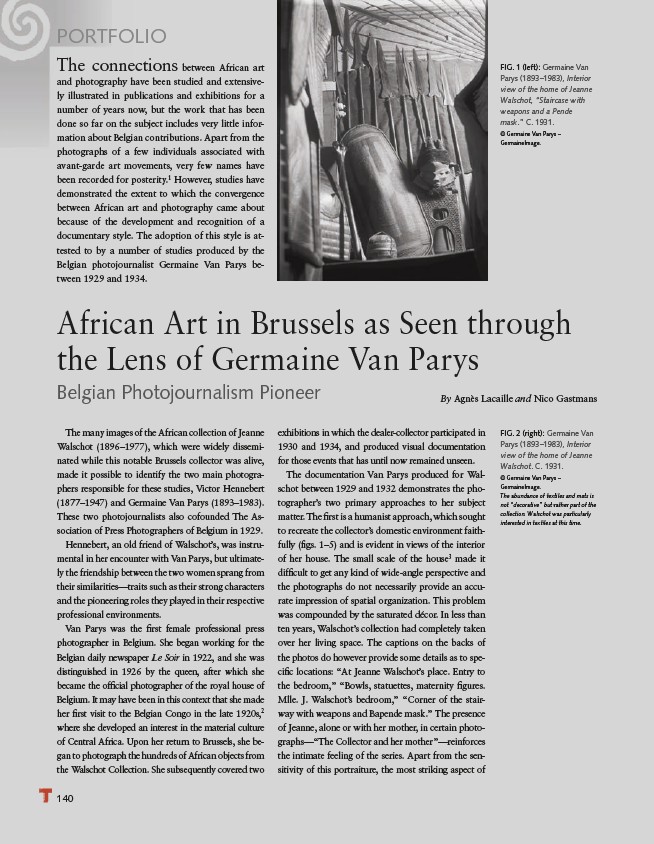
PORTFOLIO
FIG. 1 (left): Germaine Van
Parys (1893–1983), Interior
view of the home of Jeanne
Walschot, “Staircase with
weapons and a Pende
mask.” C. 1931.
© Germaine Van Parys –
GermaineImage.
African Art in Brussels as Seen through
the Lens of Germaine Van Parys
Belgian Photojournalism Pioneer
140
exhibitions in which the dealer-collector participated in
1930 and 1934, and produced visual documentation
for those events that has until now remained unseen.
The documentation Van Parys produced for Walschot
between 1929 and 1932 demonstrates the photographer’s
two primary approaches to her subject
matter. The fi rst is a humanist approach, which sought
to recreate the collector’s domestic environment faithfully
(fi gs. 1–5) and is evident in views of the interior
of her house. The small scale of the house3 made it
diffi cult to get any kind of wide-angle perspective and
the photographs do not necessarily provide an accurate
impression of spatial organization. This problem
was compounded by the saturated décor. In less than
ten years, Walschot’s collection had completely taken
over her living space. The captions on the backs of
the photos do however provide some details as to specifi
c locations: “At Jeanne Walschot’s place. Entry to
the bedroom,” “Bowls, statuettes, maternity fi gures.
Mlle. J. Walschot’s bedroom,” “Corner of the stairway
with weapons and Bapende mask.” The presence
of Jeanne, alone or with her mother, in certain photographs—“
The Collector and her mother”—reinforces
the intimate feeling of the series. Apart from the sensitivity
of this portraiture, the most striking aspect of
The connections between African art
and photography have been studied and extensively
illustrated in publications and exhibitions for a
number of years now, but the work that has been
done so far on the subject includes very little information
about Belgian contributions. Apart from the
photographs of a few individuals associated with
avant-garde art movements, very few names have
been recorded for posterity.1 However, studies have
demonstrated the extent to which the convergence
between African art and photography came about
because of the development and recognition of a
documentary style. The adoption of this style is attested
to by a number of studies produced by the
Belgian photojournalist Germaine Van Parys between
1929 and 1934.
FIG. 2 (right): Germaine Van
Parys (1893–1983), Interior
view of the home of Jeanne
Walschot. C. 1931.
© Germaine Van Parys –
GermaineImage.
The abundance of textiles and mats is
not “decorative” but rather part of the
collection. Walschot was particularly
interested in textiles at this time.
The many images of the African collection of Jeanne
Walschot (1896–1977), which were widely disseminated
while this notable Brussels collector was alive,
made it possible to identify the two main photographers
responsible for these studies, Victor Hennebert
(1877–1947) and Germaine Van Parys (1893–1983).
These two photojournalists also cofounded The Association
of Press Photographers of Belgium in 1929.
Hennebert, an old friend of Walschot’s, was instrumental
in her encounter with Van Parys, but ultimately
the friendship between the two women sprang from
their similarities—traits such as their strong characters
and the pioneering roles they played in their respective
professional environments.
Van Parys was the fi rst female professional press
photographer in Belgium. She began working for the
Belgian daily newspaper Le Soir in 1922, and she was
distinguished in 1926 by the queen, after which she
became the offi cial photographer of the royal house of
Belgium. It may have been in this context that she made
her fi rst visit to the Belgian Congo in the late 1920s,2
where she developed an interest in the material culture
of Central Africa. Upon her return to Brussels, she began
to photograph the hundreds of African objects from
the Walschot Collection. She subsequently covered two
By Agnès Lacaille and Nico Gastmans